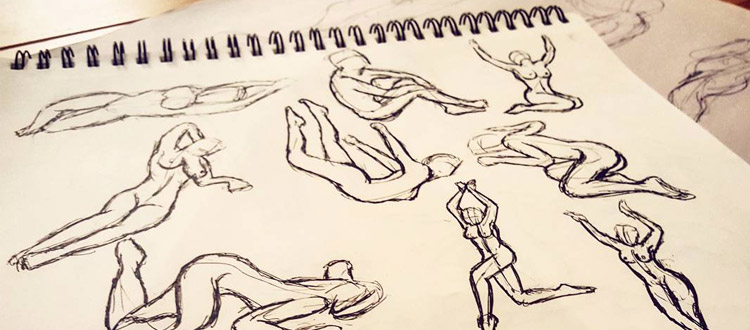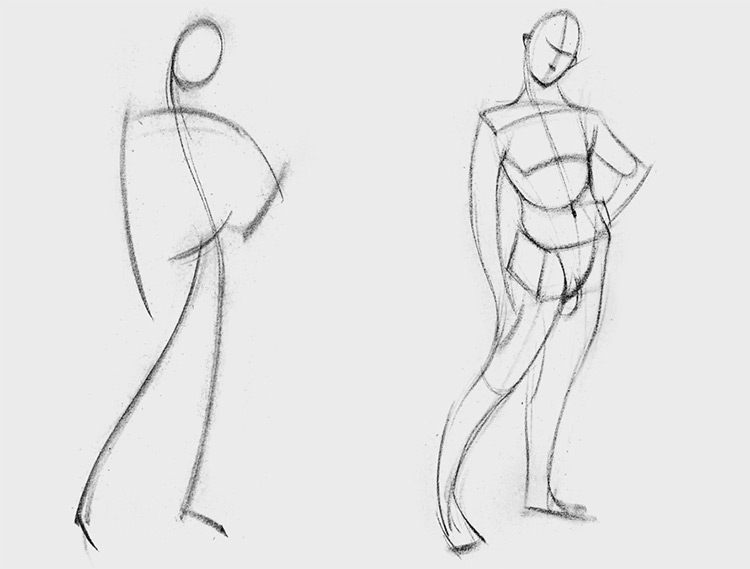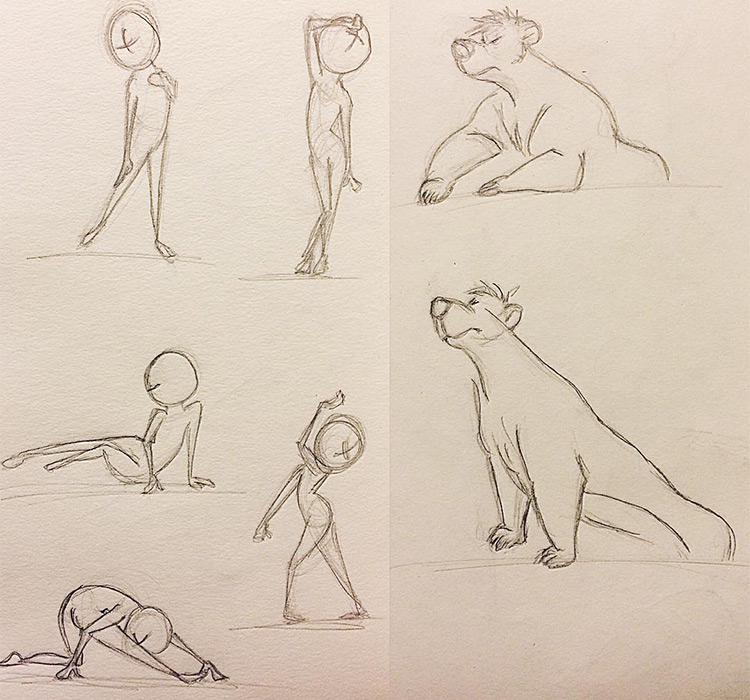How To Do Gesture Drawings Step By Step

How To Chief Gesture Drawing: Tips & Tricks For Artists
Tips Disclosure: This mail service may comprise affiliate links. That means if you purchase something we become a modest commission at no extra cost to you(larn more)
Understanding and applying gesture to your daily practice is a crucial footstep in your creative development. Gesture cartoon is a method of capturing figures in exaggerated poses. Some gesture drawings lean more towards realistic representations while others exaggerate like crazy.
The more than you exercise the more you learn to manipulate this technique. Information technology'southward a primal exercise that every artist should internalize and boom downward.
So what are the best techniques for improving your gesture drawing? I'd like to share a few tips in this post that marshal with Stan'southward advice featured in his free gesture video.
If you're brand new to gesture I actually recommend Stan's unabridged effigy cartoon fundamentals form. This is what I studied to learn gesture and information technology's still a series that I refer dorsum to from time to fourth dimension.
Goals Of Gesture
In that location are unlike goals to achieve with gesture cartoon depending on what yous're practicing. You can do quick sketches of 30-60 seconds with a goal of quickly capturing the mood. Or you tin can work much longer with an eye for realism.
Quick sketches are loose with very few lines. Your goal is to just get something downwards on the page.
At first it'due south gonna be bad. If you're looking for tips the Hampton figure book has lots of corking examples and suggestions to continue gestures loose simply realistic.
If you can ability through the bad drawings you lot'll eventually discover your rhythm. You'll learn to encounter exaggerations much easier and be able to push the motion of the trunk further than it looks in life or a photograph reference.
Ultimately the goal of all gesture is to study the figure and see how information technology moves. The human being body is very circuitous and gesture attempts to simplify the body as much every bit possible.
Anybody has their own methods for gesture cartoon which makes it a very unique practice. The almost wrong manner to do gesture is to not do it at all.
Depending on your goals there are another rules to abide by. For example, if you're going for a fully rendered drawing you want to examine the figure closely. You'll always desire to double check proportions simply there is a point where y'all tin can be looking besides much and non drawing enough.
Gesture has a lot to practice with feelings and emotions. Peculiarly if you lot're going for rough exaggerated poses. You want to conceptualize how the body is contorted to sympathise how it can be exaggerated.
Where is the torso leaning? Which leg takes most of the weight? Ask yourself questions every bit you analyze each pose and draw based on your conclusions.
In that location's a decent WikiHow guide if you want to follow a step-by-step for some nuts of gesture, although the free Proko video is much more comprehensive.
Avoid Too Many Direct Lines
If all your gestures wait like stick figures then you might be drawing too tightly.
Gesture is meant to capture movement and action. Every pose has some bend or direction that can be played upon, even if it'due south very subtle. When you lot depict with directly lines you tend to lose these natural curves and the pose ends up looking stiff.
Instead follow Stan'southward advice and employ lots of curves. Look for natural curves from the head to the torso, or from the pelvis to the feet. You can follow these lines with curves shaped like a C or an S.

However you can still end upwards with very strong gestures and this technique won't salve yous from that.
Only it'll help you meet the motility in every pose. You should be looking beyond the details to encounter which lines define each pose.
Is there a large thrust in the hip to one side? Or is in that location a sure weight-begetting leg that deserves to exist darker than the other? Just try stuff out and see how it looks.
I'd like to add together that directly lines are sometimes okay if they're defined. A leg planted firmly on the footing may use a straight line segment to show the weight. But it could also bend up at the top near the knee, or curve down into the heel. These subtleties can make a world of difference.
Since gesture drawings don't take much fourth dimension you have the freedom to experiment a lot. Utilize this to your advantage and be willing to try new stuff equally much as possible.
Don't Just Copy
When yous're going for a realist arroyo to cartoon there is a need for some copying. But this however requires an heart for values and proportions to get the drawing exactly correct.
Gesture is not meant to be a finished drawing. It'southward just a practice exercise to railroad train your eye and your ability to exaggerate. This means you shouldn't always be looking to re-create exactly what you lot see.
There is good reason to mimic parts of the pose—especially for limbs to exist in proportion with the rest of the body.
But you should care more than about how the gesture feels rather than how accurate it looks. If you tin can glance at a gesture drawing and immediately recognize how that human was posed then it's doing its job.
Everything y'all draw should consider the forms of the effigy, just never get a slave to the effigy. Understand that each function of the body is a form and has book. Try to draw your gestures with this in mind.
But don't let the contour define how your gesture appears on the page. Exist willing to break the contour every bit frequently equally y'all like. Try to detect a happy medium between pushing the pose but notwithstanding remaining true to its original position.
This will help yous avert direct copies that look boring and likewise go on you from exaggerating unrealistically.
Avoid Sloppy Linework
I was searching in Google and stumbled onto this review of Proko's gesture drawing lesson. The writer Angela brings upward the importance of make clean lines, which was also part of a Proko Q&A video.
She wrote something that I think volition resonate with many readers.
When I allowed myself to be sloppy previously, I was attempting to 'feel out' the gesture by making lots of lines till I discovered the right one. This made me lazy and less observant of the class and pose I was trying to replicate. By simplifying my marking-making, I force myself to actually really look and learn from what I run across, rather than diving in and rushing to finish.
Sloppy lines will brand it much harder to analyze your gesture. I said earlier that there aren't too many rules, and this certainly isn't a "rule" in gesture drawing.
But if you can make every mark with conviction then your gestures will be easier to look at.
If you take fourth dimension to really analyze each figure you'll get much amend quality drawings every time. Your line work will be more guided and placed with a purpose.
The best way to learn is by following Stan'southward advice in his free gesture video. Information technology'southward a smaller version of the premium course but information technology should have enough info to guide anyone towards cleaner lines.

All of this takes effort and delivery. You will not necessarily come across direct improvements in your gesture work after a single day or even a calendar week. It takes a while for this stuff to become ingrained into your muscle memory.
But proceed practicing and pay attention to your lines. Don't continue re-drawing the aforementioned line multiple times trying to find where information technology fits best.
Instead only make a line and try to get it right the first time. If it's wrong and then erase and effort once again, or just motion onto a new gesture.
The more yous practice seeing and agreement poses the easier it'll be to copy them in one swipe of the pencil.
If y'all already practice gesture then try applying these tips to your workflow. If yous're make new then check out the Proko video and get started!
Quick annotation: we also did a full review of the Proko effigy series if you lot wanna read through that too.
But these gesture drawings provide a neat way to warm upward for your twenty-four hour period of exercise. You can do 30-sixty minutes of gesture and get a lot out of the experience. This is why Disney pays for life drawing classes for all their pro artists.
A consistently recommended volume for beginners is Figure Drawing for All Information technology's Worth past Andrew Loomis. He's written dozens of books and this i is great for those merely getting into gesture.
There are many other figure drawing & gesture books out in that location providing great study materials. I don't think they're all worth grabbing, but here are a few solid recommendations.
- Strength: Dynamic Life Drawing for Animators
- Figure Information technology Out! The Beginner's Guide to Drawing People
- Figure Drawing for Artists: Making Every Mark Count
Source: https://conceptartempire.com/tips-for-gesture-drawing/
Posted by: dipalmadight1942.blogspot.com


0 Response to "How To Do Gesture Drawings Step By Step"
Post a Comment